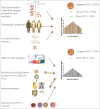Factors Associated with the Size of HIV DNA Reservoir
- PMID: 28091416
- PMCID: PMC5282681
- DOI: 10.4103/0366-6999.198009
Factors Associated with the Size of HIV DNA Reservoir
Abstract
Objective: To review the recent literatures related to the factors associated with the size of the HIV reservoir and their clinical significance.
Data sources: Literatures related to the size of HIV DNA was collected from PubMed published from 1999 to June 2016.
Study selection: All relevant articles on the HIV DNA and reservoir were collected and reviewed, with no limitation of study design.
Results: The composition and development of the HIV-1 DNA reservoir in either treated or untreated patients is determined by integrated mechanism comprising viral characteristics, immune system, and treatment strategies. The HIV DNA reservoir is a combination of latency and activity. The residual viremia from the stochastic activation of the reservoir acts as the fuse, continuing to stimulate the immune system to maintain the activated microenvironment for the rebound of competent virus once treatment with antiretroviral therapy is discontinued.
Conclusion: The size of the HIV-1 DNA pool and its composition has great significance in clinical treatment and disease progression.
Conflict of interest statement
There are no conflicts of interest.
Figures
Similar articles
-
HIV-1 DNA and RNA kinetics in primary HIV infection.J Biol Regul Homeost Agents. 2002 Jan-Mar;16(1):49-52. J Biol Regul Homeost Agents. 2002. PMID: 12003174
-
CD4 T cell nadir independently predicts the magnitude of the HIV reservoir after prolonged suppressive antiretroviral therapy.J Clin Virol. 2012 Jan;53(1):29-32. doi: 10.1016/j.jcv.2011.09.018. Epub 2011 Oct 22. J Clin Virol. 2012. PMID: 22019250
-
Potential implication of residual viremia in patients on effective antiretroviral therapy.AIDS Res Hum Retroviruses. 2015 Jan;31(1):25-35. doi: 10.1089/AID.2014.0194. AIDS Res Hum Retroviruses. 2015. PMID: 25428885 Free PMC article. Review.
-
HIV DNA loads, plasma residual viraemia and risk of virological rebound in heavily treated, virologically suppressed HIV-infected patients.Clin Microbiol Infect. 2015 Jan;21(1):103.e7-103.e10. doi: 10.1016/j.cmi.2014.08.004. Epub 2014 Oct 13. Clin Microbiol Infect. 2015. PMID: 25636935
-
Reservoirs for HIV-1: mechanisms for viral persistence in the presence of antiviral immune responses and antiretroviral therapy.Annu Rev Immunol. 2000;18:665-708. doi: 10.1146/annurev.immunol.18.1.665. Annu Rev Immunol. 2000. PMID: 10837072 Review.
Cited by
-
Monitoring HIV DNA and cellular activation markers in HIV-infected humanized mice under cART.Virol J. 2018 Dec 17;15(1):191. doi: 10.1186/s12985-018-1101-9. Virol J. 2018. PMID: 30558630 Free PMC article.
-
An atlas of immune cell transcriptomes in human immunodeficiency virus-infected immunological non-responders identified marker genes that control viral replication.Chin Med J (Engl). 2023 Nov 20;136(22):2694-2705. doi: 10.1097/CM9.0000000000002918. Epub 2023 Nov 1. Chin Med J (Engl). 2023. PMID: 37914674 Free PMC article.
-
Mycobacterium tuberculosis co-infection is associated with increased surrogate marker of the HIV reservoir.AIDS Res Ther. 2020 Oct 19;17(1):63. doi: 10.1186/s12981-020-00320-0. AIDS Res Ther. 2020. PMID: 33076959 Free PMC article.
-
Heterogeneity of HIV-1 latent reservoirs.Chin Med J (Engl). 2020 Dec 5;133(23):2867-2873. doi: 10.1097/CM9.0000000000001085. Chin Med J (Engl). 2020. PMID: 33273337 Free PMC article.
-
Clinical Relevance of Total HIV DNA in Peripheral Blood Mononuclear Cell Compartments as a Biomarker of HIV-Associated Neurocognitive Disorders (HAND).Viruses. 2017 Oct 31;9(11):324. doi: 10.3390/v9110324. Viruses. 2017. PMID: 29088095 Free PMC article. Review.
References
-
- De Clercq E. Tenofovir alafenamide (TAF) as the successor of tenofovir disoproxil fumarate (TDF) Biochem Pharmacol. 2016;119:1–7. doi:10.1016/j.bcp.2016.04.015. - PubMed
-
- Swartz JE, Vandekerckhove L, Ammerlaan H, de Vries AC, Begovac J, Bierman WF, et al. Efficacy of tenofovir and efavirenz in combination with lamivudine or emtricitabine in antiretroviral-naive patients in Europe. J Antimicrob Chemother. 2015;70:1850–7. doi:10.1093/jac/dkv033. - PubMed
-
- Li T, Guo F, Li Y, Zhang C, Han Y, Lye W, et al. An antiretroviral regimen containing 6 months of stavudine followed by long-term zidovudine for first-line HIV therapy is optimal in resource-limited settings: A prospective, multicenter study in China. Chin Med J. 2014;127:59–65. doi:10.3760/cma.j.issn.0366-6999.20132557. - PubMed
Publication types
MeSH terms
Substances
LinkOut - more resources
Full Text Sources
Medical


